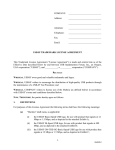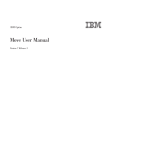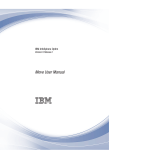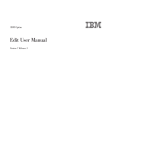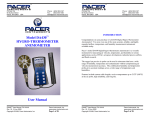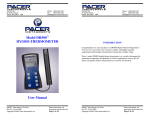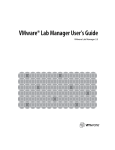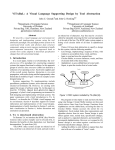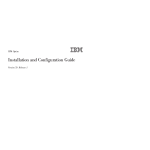Download 7. Data Privacy Option for Oracle E
Transcript
7. Data Privacy Option for Oracle E-Business Suite This section contains information on using the Optim Data Privacy option in conjunction with the Optim Test Data Management Solution for Oracle E-Business Suite. The data privacy option enables you to mask sensitive data on nonproduction instances of an Oracle E-Business database (including test, training, and development environments). The data privacy definitions provide the means to easily de-identify, mask and transform sensitive data in the HRMS module of Oracle Applications version 11.5.10. If your current Test Data Management configuration does not include the Data Privacy option and you would like that functionality, contact your IBM sales representative. This chapter includes the following topics: • Data Privacy Overview • Installing the Data Privacy Option • Data Privacy Implementation • Scenario - Core HRMS Module • Data Privacy Reference Material Installation and Configuration Guide 53 7. Data Privacy Option for Oracle E-Business Suite Prerequisites The Data Privacy option is an added feature of the Test Data Management Solution and has the same hardware and software requirements as outlined in Section 1.1 Hardware and Software Requirements. For more information, see the Detailed System Requirements document for the Test Data Management Solution for Oracle E-Business Suite at the following site: http://www.ibm.com/support/ search.wss?tc=SSC4TGP&sort=des&dc=DA420&dtm 54 Optim TDM and DP Solutions for Oracle E-Business Suite 7.1 Data Privacy Overview 7.1 Data Privacy Overview Every company is required to protect personal employee information such as addresses and Social Security numbers. Use the Optim Data Privacy option to efficiently maintain a working database of employee information that is secure and safe to use for test, development and training environments. Different approaches can be used to mask data in your Oracle EBusiness database. The following approaches involve extracting and inserting data into a target database. • You can mask the extracted data from an Optim Extract Request when you insert it into your target database. • When you use Data Privacy in conjunction with Test Data Management, a more secure approach is to mask the extracted data when you insert data into a clone of your production database. The masked clone is then used as a source for subsequent non-production databases environments. Installation and Configuration Guide 55 7. Data Privacy Option for Oracle E-Business Suite 7.1.1 Data Privacy Implementation Architecture To implement the Data Privacy option, extract data from your production database and mask sensitive data as you insert it into your target database. During the insert process, Optim uses the provided Data Privacy definitions to mask your data. In this approach, you must first set up your test environment. If you are using the Data Privacy option with the Test Data Management Solution, you will have already created a database clone of the production database and run scripts to truncate tables, reorganize table spaces, and reset sequences in your new target database. See Section 1.2 Creating an Oracle E-Business Target Environment and Appendix B. Truncating Target Tables for more information on setting up your test environment. With the test environment in place, you can mask data using the Data Privacy option. To do this, perform the following steps: 56 1. Extract the production data you will mask using an Extract Request. 2. Insert the extracted data into the target database using the Data Privacy definitions provided in the Data Privacy Column Map. This step masks your data. Optim TDM and DP Solutions for Oracle E-Business Suite 7.1 Data Privacy Overview 7.1.2 Data Privacy Implementation Architecture with TDM An alternate method for implementing the Data Privacy option masks the data in a cloned master database. After masking the new database (the Gold Master database) is used as the source for test, development, or training environments. This approach provides additional flexibility and security when distributing masked data across multiple non-production databases. To set up a masked Gold Master database to use as the source for your target environment, perform the following steps: 1. Create a clone of the production database. 2. Extract the data to be privatized from the clone by running an Optim Extract Request. 3. Insert the extracted data into the cloned database using the data privacy definitions in the Data Privacy Column Map. This step creates your Gold Master database. Installation and Configuration Guide 57 7. Data Privacy Option for Oracle E-Business Suite You can use the Gold Master database as your secure source for your target environment. To create a target environment, perform the following steps: 1. Clone the masked Gold Master database to a target database. 2. Extract the masked data from Gold Master using the Optim Test Data Management Solution for Oracle E-Business. 3. Insert the extracted data into the target database. 4. You can then run truncate scripts to reduce the database size and run reset scripts to reset the target database sequences (optional). Note: 58 For more information on truncating your database see Appendix B. Truncating Target Tables on page 123. For more information on resetting database sequences see Resetting Sequences on page 31. Optim TDM and DP Solutions for Oracle E-Business Suite 7.2 Installing the Data Privacy Option 7.2 Installing the Data Privacy Option Before you can successfully mask the Core HRMS data, you must properly install and configure the Optim Data Privacy option. Perform the following steps: 1. Install and configure the Test Data Management Solution 2. Import data privacy definitions 3. Create data privacy objects 7.2.1 Install and Configure the Test Data Management Solution Before you can use the Data Privacy option you must install and configure Optim as described in Chapter 2. Installing Optim. The Data Privacy option uses many of the Optim Data Privacy tables. These tables must be loaded when configuring the first workstation. 7.2.2 Import Data Privacy Definitions The Optim Data Privacy option installation includes an import file that contains the Optim data privacy definitions needed to extract and mask Core HRMS data from your Oracle E-Business source database and insert the data into your target database. Import the file into the Optim Directory and verify that the definitions are imported successfully. The import file contains the following definitions, which are needed to extract the complete business object defined by the Installation and Configuration Guide 59 7. Data Privacy Option for Oracle E-Business Suite Oracle E-Business module, mask the data, and insert the data into the target database. Module Object Object Name Core Human Resources Management Systems (HRMS) Access Definition ADCHR11510DP Extract Request ERCHR11510DP Insert Request IRCHR11510DP Table Map TMCHR11510DP Column Map CMPHN11510DP CMADR11510DP CMCHR11510DP • Access Definition - An Access Definition identifies the Start Table, related tables, primary keys, relationships, and selection criteria that define the data you want to extract from your source database. • Extract Request - An Extract Request initiates the Extract Process, which allows you to copy a set of related rows from one or more tables and stores this data in an Extract File. The Extract Request references an Access Definition that defines the data to be extracted. • Insert Request - An Insert Request initiates the Insert Process, which copies data from a source file into specified destination tables. The Insert Request specifies an Extract File containing the data you want to insert into your target database and the parameters needed to run the process. The Insert Request references a Table Map to map the destination for the data to be inserted. • Table Map - A Table Map defines specifications for correlating source and destination tables of compatible data. A Table Map can map tables that have different names, modify table names, 60 Optim TDM and DP Solutions for Oracle E-Business Suite 7.2 Installing the Data Privacy Option exclude tables from a process, or include Column Maps for greater control over the data. Table Maps can be used in a Convert, Insert, or Load process, or with the Create Utility. • Column Map - A Column Map defines the specifications for mapping columns of compatible data between source and destination tables. You can map columns that have different names, modify data, or exclude columns from a process. You can include one or more Column Maps in a Table Map when you create a request to compare, convert, insert, load, or restore data. Import the Optim Data Privacy Definitions Use the following procedure to import the data privacy definitions into your Optim directory. 1. In the Optim main window, select Utilities > Import. 2. In the Import window, Process tab, click the Input File browse button to open the Open window. 3. Open OAHRCHR11510DP.txt from the Import/gaAD folder. 4. Select all available check boxes in the Definitions box. 5. Select Overwrite existing definitions (if definitions already exist in the Optim directory). 6. On the DB Aliases tab, enter the DB Alias for your source and target databases in New DB Alias. (The Optim definitions include the default source DB Alias PSTSRC and target DB Alias PSTAPP.) 7. Select File > Run, or click the Run icon. 8. Click the Show process log icon to check for errors and view the status of the Import process. 9. Close the Import window. Installation and Configuration Guide 61 7. Data Privacy Option for Oracle E-Business Suite Validate Imported Definitions When you have finished importing the Data Privacy definitions, you can verify that the definitions were imported successfully using the following procedure: 1. From the Definitions menu on the Optim main window, select Access Definition to open the Access Definition Editor. 2. From the File menu on the Access Definition Editor, select Open to open the Open an Access Definition window. 3. In the Identifier box in the Open an Access Definition window, double-click the identifier for the Access Definition, A4SOAE. 4. In the Access Definition grid, double-click the Access Definition name to open the Access Definition in the editor. 5. On the Tables tab, note the Type value for each listed table: • “Table” indicates that the import was successful. • “DB Alias Unknown” indicates that the DB Alias referenced in the Access Definition does not exist. Check and correct the Default Qualifier (dbalias.tableowner) to ensure the dbalias portion matches the DB Alias you created for your source database. • “Unknown” indicates that the table does not exist or the tableowner referenced in the Access Definition is incorrect. Check and correct the Default Qualifier (dbalias.tableowner) to ensure the tableowner portion matches the schema name for the table. 6. On the Relationships tab, clear Use new relationships. Note the Status value for each listed relationship: • Blank indicates that the relationship is defined and not new. 62 Optim TDM and DP Solutions for Oracle E-Business Suite 7.2 Installing the Data Privacy Option • “New” indicates that the relationship is new. • “Unknown” indicates that the relationship is not defined because the table has been deleted from the database or Optim Directory, or the Default Qualifier on the Tables tab has been changed. You can change the Default Qualifier (dbalias.tableowner) to ensure the dbalias portion matches the DB Alias for your source database. You can also import the Optim definitions again for the source DB Alias. • “Ref” indicates that the relationship is ignored because the parent or child table is specified as a reference table on the Tables tab. 7. Close the Access Definition Editor. 7.2.3 Create Data Privacy Objects To mask name and address columns, the Data Privacy option first creates master lookup tables with realistic yet fictionalized entries from the sample data that was loaded during Optim installation. The Data Privacy option uses a view of these lookup tables as the foundation for lookup-based masking functions. To mask name entries, Optim matches unique Oracle ID numbers from the master lookup table and the destination table. Optim uses the corresponding values from the lookup table to create a view. To mask address entries, Optim accesses multiple lookup tables and creates a view with data from different geographies. As with masking names, Optim matches the unique Oracle IDs from the various source tables and the destination table. The resulting view maintains geographically realistic address data that will be used in masking your data. The Data Privacy option provides a script in the sql folder of the installation directory to create the objects that are necessary for using the option. Installation and Configuration Guide 63 7. Data Privacy Option for Oracle E-Business Suite Use SQL*Plus to run the “create_optim_ebs_dp_objects.sql” script and create Data Privacy objects including control tables, lookup tables, and materialized views. The script creates the following objects. Object Type Object Name Table OPTIM_EBS_DP_LKP_CONTROL Table OPTIM_EBS_DP_NAMES_LKP_MASTER Table OPTIM_EBS_DP_ADDRS_LKP_MASTER Package OPTIM_EBS_DP_LKP_PKG Package Body OPTIM_EBS_DP_LKP_PKG Procedure INSERT_CNTRL_DATA Procedure INSERT_NAMES_DATA Procedure INSERT_ADDRESSES_DATA Procedure CREATE_MVIEWS Materialized View OPTIM_EBS_DP_NAMES_LKP_MV Materialized View OPTIM_EBS_DP_ADDRESSES_LKP_MV Many of these objects can be customized to meet the particular data privacy needs of your organization. See Data Privacy Objects on page 84 for more information on customizing data privacy objects. With the Data Privacy objects set up, you can now implement the Data Privacy option. 64 Optim TDM and DP Solutions for Oracle E-Business Suite 7.3 Implementing the Data Privacy Option 7.3 Implementing the Data Privacy Option To implement the Data Privacy option, you must set up your target database environment. Once you have the proper environment in place, extract data from the production database and insert the extracted data into the target database using the provided data privacy definitions. The result is a privatized database with usable data. 7.3.1 Set Up Environment First, you must set up your Oracle E-Business target database environment. 1. Clone the source (production) Oracle E-Business database to create the target database (for example, development, testing, or training). This clone contains the current production data. 2. Use the Test Data Management truncate scripts on the target database to truncate the tables from which you will extract data in the source database. (See Appendix B. Truncating Target Tables.) Reorganize the target table spaces to reduce the size of the database. 3. Ensure that the Optim Server is configured with connectivity to both the source and target databases (see Chapter 2. Installing Optim). Import the Optim definitions (see Import Data Privacy Definitions on page 59). 7.3.2 Run the Extract Request Next, run an Extract Request using Optim. Use the following procedure to extract data from the source database. 1. On the Optim main window, select File > Open. 2. In the Identifier pane on the Open window, expand Extract Request and double-click the identifier associated with the import file, A4SOAE. Double-click the grid row for the Installation and Configuration Guide 65 7. Data Privacy Option for Oracle E-Business Suite appropriate Extract Request.(Refer to the table in Section 7.2.3 Create Data Privacy Objects on page 63). 3. On the Extract Request Editor, General tab, enter a name for the Extract File or use the specified default. Verify that the correct Access Definition is specified. (Refer to the table in Section 7.2.3 Create Data Privacy Objects on page 63). 4. Select Tools > Edit Access Definition to open the Access Definition Editor. Ensure Default Qualifier contains the correct DB Alias and Creator ID for your source database. Close the Access Definition Editor. 5. On the Extract Request Editor, Objects tab, verify that only Objects are selected, not Extended Objects. 6. Select File > Run to create the Extract File. 7. On the Extract File Variable Values dialog, enter values to identify the selection criteria that Optim will use to extract user data. Set the boundaries for the Person IDs that will be used to generate privatized data from the view. Set the upper and lower limits of the PERSON_FROM and PERSON_TO variable values. 8. When the Extract Process is complete, you can view the results in the Extract Process Report. 9. Close the Extract Request Editor. 7.3.3 Mask and Insert the Extract File Data Use the following procedure to mask and insert your data into the target database. 66 1. On the Optim main window, select File > Open. 2. In the Identifier pane on the Open window, expand Insert Request and double-click the identifier associated with the Optim TDM and DP Solutions for Oracle E-Business Suite 7.3 Implementing the Data Privacy Option Insert Request, A4SOAE. Double-click the grid row for the Insert Request to open the Insert Request Editor (Refer to the table in Section 7.2.3 Create Data Privacy Objects on page 63). 3. On the Insert Request Editor, enter the Server Name. On the General tab, select the name of the Source File or click the Retrieve last created Source File button to retrieve the name of the last created Extract File. 4. Enter a Control File name or select an existing one. 5. In the Table Map Options group box, select Named. Click the browse button to open the Select a Table Map window. In the Identifier pane, double-click the identifier associated with the Table Map, A4SOAE. Double-click the grid row for the appropriate Core HRMS Table Map to populate the Table Map name on the Insert Request Editor. 6. On the Insert Request Editor, select Tools > Edit Table Map to open the Table Map Editor. Click the Destination Qualifier down arrow and select the qualifier for tables in your target database. (You can also click the browse button to open the Select a Default Destination Qualifier window.) Close the Table Map Editor and save changes. 7. On the Insert Request Editor, General tab, select Insert in the Process Options group box when you request the first Insert for a module. For subsequent Insert Requests, select Update/ Insert. 8. In the Disable Triggers and Disable Constraints group boxes, select Always. 9. Select File > Run to insert data from the Extract File into your target database. Installation and Configuration Guide 67 7. Data Privacy Option for Oracle E-Business Suite 10. When the Insert Process is complete, you can view the results in the Insert Process Report. 11. Close the Insert Request Editor. 7.3.4 Verify Masked Data Be sure to verify that your sensitive data has been successfully masked. Use Optim Compare or another method to confirm that the values in your target database have been replaced with meaningful yet fictional data. For more information on using Optim Compare refer to the Optim Compare User Manual. 68 Optim TDM and DP Solutions for Oracle E-Business Suite 7.4 Scenario - Core HRMS Module 7.4 Scenario - Core HRMS Module The following scenario illustrates how to use the Data Privacy option in conjunction with the Test Data Management Solution for Oracle E-Business Suite. The scenario assumes that you have already installed Optim, and configured the DB Aliases used in this scenario (as described in Chapter 2. Installing Optim). The scenario also assumes you have the Data Privacy option as part of your Test Data Management Solution configuration, and have created a target database with a subset of your Core HRMS records. The personal information you will extract from your database was created by the HRMS module. This scenario includes the following steps: 1. Extract Core HRMS data from the source database. 2. Edit the Optim Data Privacy definitions. 3. Mask and insert data in the target database. Installation and Configuration Guide 69 7. Data Privacy Option for Oracle E-Business Suite 7.4.1 Extract Core HRMS Data from the Source Database Once you have set up the environment, use Optim to extract Core HRMS personal data from your source database. 70 1. On the Optim main window, select File > Open. 2. In the Identifier pane on the Open window, expand Extract Request and double-click the identifier associated with the Extract Request, A4SOAE. Double-click the grid row for the Extract Request, ERCHR11510DP, to open the Extract Request Editor. Optim TDM and DP Solutions for Oracle E-Business Suite 7.4 Scenario - Core HRMS Module 3. On the Extract Request Editor, General tab, enter a name for the Extract File or use the specified default. Verify that the correct Access Definition is specified (ADCHR11510DP). Click the browse button to select the Access Definition name. 4. Select Tools > Edit Access Definition to open the Access Definition Editor. Change the Default Qualifier to the correct DB Alias and Creator ID for your source database. 5. On the Extract File Variable Values dialog, enter Person ID values for PERSON_FROM and PERSON_TO. The range Installation and Configuration Guide 71 7. Data Privacy Option for Oracle E-Business Suite between the two values should equal or exceed the number of entries being masked. 72 6. Select File > Run or click the Run icon to create the Extract File. 7. Disregard any warnings about NEW relationships. 8. When the Extract Process is complete, you can view the results in the Extract Process Report. 9. Close the Extract Request Editor. Optim TDM and DP Solutions for Oracle E-Business Suite 7.4 Scenario - Core HRMS Module 7.4.2 Edit the Data Privacy Definitions Before inserting your data, edit the Optim HRMS definition for privatizing age information using the Column Map Editor. 1. On the Optim main window, select Definitions > Column Map. 2. On the Column Map Editor window, select File > Open. 3. Select the Column Map with PER_ALL_PEOPLE_F in the Table column. 4. In the Source section of the Respecify Column Map Tables window, browse for your Extract File or select the file from Installation and Configuration Guide 73 7. Data Privacy Option for Oracle E-Business Suite the drop down menu. Select the PER_ALL_PEOPLE_F table from the Table list and click OK. 5. 74 In the Column Map Editor, update row 14 with a new Data Privacy definition. The default masking technique is to age a column value by 2 years, 6 months, 40 weeks, and 15 days, and apply a rule, using the following Age Function: Optim TDM and DP Solutions for Oracle E-Business Suite 7.4 Scenario - Core HRMS Module AGE(+2Y,+6M,+40W,+15D,RU=NEXTPAYDAY) Instead, use a different masking technique that alters the column value using a Default Adjustment. Update the value by using the following the Age Function: AGE(DEF,RU=NEXTPAYDAY) 6. Save and close the Column Map Editor. Installation and Configuration Guide 75 7. Data Privacy Option for Oracle E-Business Suite 7.4.3 Insert the Extract File Once you have your Extract File, use Optim to insert the HRMS personal data into the target database using the Data Privacy definitions. 76 1. On the Optim main window, select File > Open. 2. In the Identifier pane on the Open window, expand Insert Request and double-click the identifier associated with the Insert Request, A4SOAE. Double-click the grid row for the appropriate Insert Request (see the table in Section 7.2.3 Create Data Privacy Objects on page 63) to open the Insert Request Editor. 3. On the Insert Request Editor, enter the Server Name. On the General tab, select the name of the Source File or click the Optim TDM and DP Solutions for Oracle E-Business Suite 7.4 Scenario - Core HRMS Module Retrieve last created Source File button name of the last created Extract File. to retrieve the 4. Enter a Control File name or select an existing one. 5. In the Table Map Options group box, select Named. Click the browse button to open the Select a Table Map window. In the Identifier pane, double-click the identifier associated with the Table Map, A4SOAE. Double-click the grid row for the appropriate Table Map (see the table in Section 7.2.3 Create Data Privacy Objects on page 63) to populate the Table Map name on the Insert Request Editor window. Installation and Configuration Guide 77 7. Data Privacy Option for Oracle E-Business Suite 6. On the Insert Request Editor, select Tools > Edit Table Map to open the Table Map Editor. Click the Destination Qualifier down arrow and select the qualifier for tables in your target database. (You can also click the browse button to open the Select a Default Destination Qualifier window.) Close the Table Map Editor and save changes. 7. On the Insert Request Editor, General tab, select Insert in the Process Options group box when you request the first Insert process for a module. For subsequent Insert Requests, select Update/Insert. 8. In the Disable Triggers and Disable Constraints group boxes, select Always. 9. Select File > Run to insert data from the Extract File into your target database. 10. When the Insert Process is complete, you can view the results in the Insert Process Report. 11. Close the Insert Request Editor. 7.4.4 Verify the Target Database Log on to Oracle E-Business and access the target database. Verify that the personal data has been masked. Select the HRMS system and navigate to the employee information screen. Verify that the HRMS data has been masked. You now have a working database with privatized and usable data. 78 Optim TDM and DP Solutions for Oracle E-Business Suite 7.5 Data Privacy Reference Material 7.5 Data Privacy Reference Material This section covers the following information: • Masking methods • Oracle HRMS Database Tables • Oracle HRMS Columns for Masking • Data Privacy Objects 7.5.1 Masking Methods Depending on the column, the Data Privacy option masks sensitive data using one of several functions. For detailed information on each function refer to the Optim Common Elements Manual. Lookup Function For names and addresses, the Data Privacy option uses lookup tables to mask information while keeping the data usable. The Column Map lookup function populates the destination column based on a “view” that is created from the source table using an SQL script. The Lookup Function selects values based on the entries in the source table. Hash Lookup Function The Hash Lookup Function obtains the value for a destination column from a lookup table, according to a hashed value derived from a source column. The Hash Lookup Function allows you to consistently mask data using the same source and lookup tables in any environment. AGE Function The Age Function is used to age values in a source column. The source column can contain character, numeric, date, or timestamp data. Note that a CHAR or VARCHAR column has a maximum Installation and Configuration Guide 79 7. Data Privacy Option for Oracle E-Business Suite length of 256 bytes. The Age Function is formatted as: AGE(parameters) TRANS COL Function The TRANS COL function can mask data that has no inherent format or a format that is not widely known. TRANS COL maintains the format and character type of the source data at the destination. Data types CHAR, VARCHAR and non-float numeric can be masked with TRANS COL. Alphabetic and numeric characters are masked, but any other characters in the source data are copied to the destination without being changed. You can generate unique values for unique source data. For non-unique source data, you can generate a different value for each occurrence of the same source and you can generate values with a length different from the source. The source data format and character type determines the format and character type of the destination data. If the source data is uppercase alphabetic characters, the output generated at the destination is uppercase alphabetic. For more information on the TRANS COL function, see the TRANS COL Data Privacy Function support document at the following site: http://www-01.ibm.com/support/ docview.wss?rs=0&context=SSCGNPF&context=SSCGNPH&co ntext=SSC253J&dc=DB550&dc=DB560&uid=swg21424217&lo c=en_US&cs=utf-8&lang= 80 Optim TDM and DP Solutions for Oracle E-Business Suite 7.5 Data Privacy Reference Material 7.5.2 Oracle HRMS Database Tables Below are the Oracle Core HRMS Schema tables that contain the personal information that is masked using the Data Privacy option: • PER_ALL_PEOPLE_F • PER_PHONES • PER_ADDRESSES PER_ALL_PEOPLE_F The PER_ALL_PEOPLE_F table holds personal information for individuals associated with the HR department. Individuals include employees, applicants, ex-employees, ex-applicants, contacts and other site-specific categories of people. PER_PHONES The PER_PHONES table holds phone numbers for current employees, former employees and other contacts. PER_ADDRESSES The PER_ADDRESSES table holds address information for current and ex-employees and other contacts. See Oracle documentation for pertinent information regarding the handling of primary addresses. Installation and Configuration Guide 81 7. Data Privacy Option for Oracle E-Business Suite 7.5.3 Oracle HRMS Columns for Masking The following columns in the Core HRMS tables will be considered for masking. Column Name Table Name Masking Type Last Name PER_ALL_PEOPLE_F Values are masked with a meaningful Last Name from the Lookup Table. First Name PER_ALL_PEOPLE_F Values are masked with a meaningful First Name from the Lookup Table. Middle Name PER_ALL_PEOPLE_F If the source columns are populated, the new value is randomly picked (name or initial) from the Lookup View based PERSON_ID. Known As PER_ALL_PEOPLE_F Values are randomly substituted only if source is not null. Previous Name PER_ALL_PEOPLE_F If the record qualifies for Previous Name, non-null values from the source data are populated from Lookup values. Email ID PER_ALL_PEOPLE_F Lookup values are populated based on person ID and the new masked name assigned to the non-production environment. User can determine the e-mail suffix based on lookup values setup. Employee Number PER_ALL_PEOPLE_F The Optim Random function is used to mask the data in this column. Replacement values must conform to the same formatting as the original source value. The masking technique will synchronize data to the EMPLOYEE_NUMBER in the PER_ALL_ASSIGNMENTS_F table and other applicable areas. National Identifier/SSN PER_ALL_PEOPLE_F This column uses the Optim Trans Col Function for U.S. geography data to mask government ID data. 82 Optim TDM and DP Solutions for Oracle E-Business Suite 7.5 Data Privacy Reference Material Column Name Table Name Masking Type Date of Birth PER_ALL_PEOPLE_F This key column is used as a unique identifier in many cases. The data is masked and the validity is checked. Birth dates are replaced by a range of random dates ensuring that the age is not too old or young. Town of Birth PER_ALL_PEOPLE_F Standard Optim masking techniques of either Lookup or Random functions are used. Region of Birth PER_ALL_PEOPLE_F Standard Optim masking techniques of either Lookup or Random functions are used. Country of Birth PER_ALL_PEOPLE_F Standard Optim masking techniques of either Lookup or Random functions are used. Address Line 1 PER_ADDRESSES The first line is given a meaningful yet fictional street address and the remainder is set to null unless there is a requirement for multi-line street addresses. Address Line 2 PER_ADDRESSES The first line is given a meaningful yet fictional street address and the remainder is set to null unless there is a requirement for multi-line street addresses. Address Line 3 PER_ADDRESSES The first line is given a meaningful yet fictional street address and the remainder is set to null unless there is a requirement for multi-line street addresses. City PER_ADDRESSES This column is set from a list of town or city names. Zip PER_ADDRESSES This field is masked as a valid value based on City and State. Installation and Configuration Guide 83 7. Data Privacy Option for Oracle E-Business Suite Column Name Table Name Masking Type County PER_ADDRESSES Depending on the City, State and Zip Code combination, the county value is populated using the algorithm or lookup values. Phone Number PER_ADDRESSES Phone numbers are replaced with realistic random data. PER_PHONES License Number PER_ALL_PEOPLE_F If the source values are populated, then a random number or null is replaced on the target database. There is no Oracle application integrity built on this column value. Work Phone PER_ALL_PEOPLE_F Phone numbers are replaced with realistic random data. 7.5.4 Data Privacy Objects Control Table The OPTIM_EBS_DP_LKP_CONTROL table is the control table, which allows the end users to control the Source and Destination (Lookup) tables. Following is the structure of the table: Column Name Data type Default Column Description SEQ NUMBER NOT NULL Unique identifier MODULE VARCHAR2(3) NOT NULL Module name 'CHR' NAME VARCHAR2(60) TABLE_NAME VARCHAR2(30) 84 Table information NOT NULL Name of the table Optim TDM and DP Solutions for Oracle E-Business Suite 7.5 Data Privacy Reference Material Column Name Data type Default Column Description QUICKCODE VARCHAR2(10) Source/destination indicator (also indicates whether name or address) SN - Source Name DN - Destination Name SA - Source Address DA - Destination Address DK - Destination Known As DE - Destination Email Address CCODE VARCHAR2(30) Country Code (2 Digit) should match with Oracle Country Code ACTIVE CHAR(1) NOT NULL 'Y' Y/N value to enable/disable the use of the particular table SQLTEXT VARCHAR2(4000) NOT NULL DESCRIPTION VARCHAR2(100) SQL string Description/additional information By default, the Data Privacy option inserts the following rows in the Control Table. SEQ Mod. NAME TABLE_NAME QUICK CODE 1001 CHR 1002 CHR 2001 CCODE ACTIVE Names Source PER_ALL_PEOPLE_F SN Y Address Source PER_ADDRESSES SA Y CHR AU-Names OPTIM_AU_LASTNAME DN AU Y 2002 CHR CA-Names OPTIM_CA_LASTNAME DN CA N 2003 CHR DE-Names OPTIM_DE_LASTNAME DN DE N 2004 CHR ES-Names OPTIM_ES_LASTNAME DN ES Y 2005 CHR FR-Names OPTIM_FR_LASTNAME DN FR Y 2006 CHR IT-Names OPTIM_IT_LASTNAME DN IT Y 2007 CHR UK-Names OPTIM_UK_LASTNAME DN GB Y 2008 CHR US-Names OPTIM_US_LASTNAME DN US Y 4001 CHR AU- Addresses OPTIM_AU_ADDRESSES DA AU Y 4002 CHR CA- Addresses OPTIM_CA_ADDRESSES DA CA Y Installation and Configuration Guide 85 7. Data Privacy Option for Oracle E-Business Suite 4003 CHR UK- Addresses OPTIM_UK_ADDRESSES DA GB Y 4004 CHR DE- Addresses OPTIM_DE_ADDRESSES DA DE Y 4005 CHR ES- Addresses OPTIM_ES_ADDRESSES DA ES Y 4007 CHR FR- Addresses OPTIM_FR_ADDRESSES DA FR N 4006 CHR IT- Addresses OPTIM_IT_ADDRESSES DA IT Y 4000 CHR US- Addresses OPTIM_US_ADDRESSES DA US Y 9001 CHR E-mail Format DE Y 9002 CHR Known As Format OPTIM_EBS_DP_NAMES _LKP_MASTER OPTIM_EBS_DP_NAMES _LKP_MASTER DK Y The Optim Data Privacy option will lookup data from these target tables and mask your source table data. The control table also inserts an SQLTEXT column. To find the existing values for the SQLTEXT column, use the following command: SQL> Select Table_Name, SQLTEXT from OPTIM_EBS_DP_LKP_CONTROL; Lookup Tables Data in the name and address lookup master tables are loaded by executing the SQL string in the Control Table. The names lookup master table (OPTIM_EBS_DP_NAMES_LKP_MASTER) has the following structure: Column Name Data type NID VARCHAR2(30) Identifier. The last digit Indicates gender. (M -Male/F -Female) LASTNAME VARCHAR2(100) Last Name FIRSTNAME VARCHAR2(30) First Name E_CODE VARCHAR2(3) US Ethnicity Code (AU, CA, FR, IT, DE, ES, US, GB) ETHNICITY VARCHAR2(50) American Ethnicity (Australian, Canadian, French, Italian, German, Spanish, American, UK) 86 Default Column Description Optim TDM and DP Solutions for Oracle E-Business Suite 7.5 Data Privacy Reference Material The address lookup master table (OPTIM_EBS_DP_ADDRD_LKP_MASTER) has the following structure: Column Name Data type SEQ NUMBER Identifier ADDRESS_LINE1 VARCHAR2(100) Address Line 1 ADDRESS_LINE2 VARCHAR2(100) Address Line 2 ADDRESS_LINE3 VARCHAR2(100) Address Line 3 CITY VARCHAR2(100) Town or City COUNTY VARCHAR2(100) County - For US Address only STATE VARCHAR2(4) POSTAL_CODE VARCHAR2(16) COUNTRY VARCHAR2(2) Note: Default CA Column Description State - For US Address only Zip Code US Two digit Country Code There are city-county-state combinations in Optim Data Privacy tables which do not exist as combinations in Oracle. If addresses are masked with an invalid combination, you will get a note/error message in the Addresses Form. The error can be avoided by selecting appropriate combination of city, county and state. Modifying the Control Table For greater customization, you may modify the values of the control table. To manually change the values, run the following processes in sequence: 1. Insert data into control table. 2. Insert data into the Names Master Lookup table. 3. Insert data into the Address Master Lookup table. 4. Create materialized views. Installation and Configuration Guide 87 7. Data Privacy Option for Oracle E-Business Suite Notes: While making changes to the control table, remember that the value for MODULE is always ‘CHR’ for HRMS Data. 88 • The value in the CCODE should match the Oracle Country Code. • If you manually change any target table names for Names and Addresses in the TABLE_NAME column, the values in the SQLTEXT column must also be changed to reflect the modifications. • If the ACTIVE column value for a row is set to N, then that table will not be used in a master lookup table or materialized view. • By default, the Data Privacy option masks e-mail addressees by generating a user name from the first initial and last name of the masked entry from the name lookup. The default domain name is ‘xyzco.com’. To make changes to the default settings, you must manually edit the control table. Optim TDM and DP Solutions for Oracle E-Business Suite





































